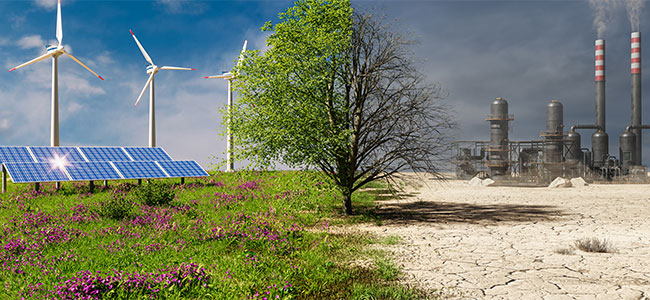Is Climate Change Now More About Mitigation? — Environmental Protection
Is Climate Change Now More About Mitigation? EP Magazine



Is Climate Change Now More About Mitigation?
The climate change conversation has shifted from prevention to mitigation and adaptation, focusing on the feasibility of strategies and expert opinions on reversing the worsening crisis amidst rising temperatures and more frequent extreme weather events.
- Apr 12, 2024
Most of what people know about climate change today are things they already knew 30 years ago. Yet, it seems not much has changed. Global temperatures are still rising, as are sea levels. If anything, the situation appears to be getting worse.
Floods, droughts, wildfires and other climate-driven disasters have become more frequent and intense through the years. As things stand, addressing the climate crisis is more about mitigation measures than prevention.
Is it Too Late to Reverse Climate Change?
Expert opinions vary on the matter. Scientists at NASA believe the effects of anthropogenic climate change are irreversible, at least in the lifetime of humans alive today. Others think there’s still ample time to fix things. Perhaps more worrying is the growing belief that nothing can be done to tackle climate change.
In 2015, world leaders and stakeholders agreed to substantially reduce global greenhouse gas emissions and limit temperature increase to 1.5°C above pre-industrial levels. However, the Intergovernmental Panel on Climate Change is skeptical about the world reaching net-zero emissions in time. What’s abundantly clear is that, without major action to reduce emissions, it will be too late to avoid the worst effects of the crisis.
How Bad Is Climate Change Now?
Rising temperatures are an urgent concern and have far-reaching implications. 2023 was already the warmest year on record and there’s a good chance that subsequent years will be even hotter. As a result, sea ice and glaciers are melting faster than ever, disrupting normal ocean circulation patterns and raising sea levels.
Extreme weather events have been occurring more frequently too, leading to increased instances of disaster displacements. Without decisive action, around 1.2 billion people could be displaced worldwide by 2050.
Regions previously affected by droughts will likely experience even worse conditions over the coming years. Around 11 percent of the contiguous U.S. is already facing severe to extreme drought as of February 2024. This means a significant part of the population is exposed to depleted water supplies and food production, among other effects.
Climate change threatens more than human life. Various animal species across the planet have had to flee their natural habitats as spontaneous shifts in weather patterns have degraded the environment. Ecosystems are also no longer following their natural cycles.
Mitigation and Adaptation Measures
To have a meaningful impact, addressing climate change requires a two-pronged approach: mitigation and adaptation.
What Does Mitigation Entail?
Mitigation primarily involves actions to reduce greenhouse gas (GHG) emissions. It encompasses a wide range of efforts across several industries that seem relatively straightforward in theory but are incredibly difficult to implement. For example, agriculture accounts for roughly 30 percent of global carbon emissions, mainly from poor resource management and energy-intensive processes. However, without this level of food production, humanity couldn’t survive.
Another sector where drastic mitigation efforts are necessary is transportation. Burning petrol, diesel and jet fuel to transport people from one place to another is causing considerable environmental harm. Electric vehicles are a promising solution, but they’re currently pricier than regular cars and trucks. So widespread use is not likely to occur anytime soon.
What about power generation? Fossil fuels like oil and coal account for a huge chunk of global carbon emissions. Switching to renewable energy sources like solar and wind is a great mitigation measure but is cost-prohibitive and therefore challenging to implement worldwide.
Despite these glaring limitations, humanity cannot afford to slack off on current GHG reduction efforts. Even the smallest actions can make a big difference. For instance, personal vehicles alone are responsible for around 58 percent of transportation-related emissions, meaning opting to walk, bike or rideshare can significantly mitigate climate change in the industry.
What Is Climate Adaptation?
Adaptation is the process of adjusting to the current and future effects of climate change. The goal is to reduce the risk of exposure to the harmful impacts of the crisis, such as extreme weather events, coastal flooding and heatwaves.
It also covers innovative solutions to climate-driven problems. For instance, soil nailing can stabilize the ground in coastal areas and other challenging terrains, facilitating safer constructions.
Given the slow pace of mitigation efforts, society has little choice but to adapt to existing climate conditions. Proper measures must be smartly implemented with due consideration to secondary benefits, such as ensuring displaced people have access to temporary shelters.
According to the International Monetary Fund (IMF), funding remains a critical challenge to climate change adaptation. Developing countries — which incidentally need these efforts the most — would need between $140 billion to $300 billion in adaptation funding by 2030.
So… Is Climate Change Really More About Mitigation?
It would appear so. Prevention is no longer an option, seeing as the world is already suffering the effects of the climate crisis. As such,
SDGs, Targets, and Indicators
| SDGs | Targets | Indicators |
|---|---|---|
| SDG 13: Climate Action | Target 13.1: Strengthen resilience and adaptive capacity to climate-related hazards and natural disasters | – Instances of disaster displacements – Rising sea levels – Extreme weather events |
| SDG 13: Climate Action | Target 13.2: Integrate climate change measures into national policies, strategies, and planning | – Mitigation and adaptation measures – Reduction of greenhouse gas emissions – Use of renewable energy sources |
| SDG 13: Climate Action | Target 13.3: Improve education, awareness-raising, and human and institutional capacity on climate change mitigation, adaptation, impact reduction, and early warning | – Public knowledge and understanding of climate change – Implementation of climate change education programs |
| SDG 13: Climate Action | Target 13.a: Implement the commitment undertaken by developed-country parties to the United Nations Framework Convention on Climate Change to a goal of mobilizing jointly $100 billion annually by 2020 from all sources to address the needs of developing countries in the context of meaningful mitigation actions and transparency on implementation and fully operationalize the Green Climate Fund through its capitalization as soon as possible | – Funding for climate change adaptation in developing countries |
1. Which SDGs are addressed or connected to the issues highlighted in the article?
SDG 13: Climate Action
The article primarily addresses the issue of climate change and its impacts, which aligns with SDG 13: Climate Action. The article discusses the need for mitigation and adaptation measures to address climate change and highlights the urgency of reducing greenhouse gas emissions and addressing the effects of rising temperatures and extreme weather events.
2. What specific targets under those SDGs can be identified based on the article’s content?
Target 13.1: Strengthen resilience and adaptive capacity to climate-related hazards and natural disasters
The article mentions the increasing frequency of extreme weather events, such as floods, droughts, wildfires, and their impact on displacing people. This aligns with Target 13.1, which focuses on strengthening resilience and adaptive capacity to climate-related hazards and natural disasters.
Target 13.2: Integrate climate change measures into national policies, strategies, and planning
The article discusses the need for mitigation measures to reduce greenhouse gas emissions and mentions the challenges in implementing these measures in various sectors such as agriculture, transportation, and power generation. This aligns with Target 13.2, which emphasizes integrating climate change measures into national policies, strategies, and planning.
Target 13.3: Improve education, awareness-raising, and human and institutional capacity on climate change mitigation, adaptation, impact reduction, and early warning
The article mentions the importance of public knowledge and understanding of climate change and highlights the need for education and awareness-raising on climate change mitigation and adaptation. This aligns with Target 13.3, which focuses on improving education, awareness-raising, and human and institutional capacity on climate change.
Target 13.a: Implement the commitment undertaken by developed-country parties to the United Nations Framework Convention on Climate Change to a goal of mobilizing jointly $100 billion annually by 2020 from all sources to address the needs of developing countries in the context of meaningful mitigation actions and transparency on implementation and fully operationalize the Green Climate Fund through its capitalization as soon as possible
The article mentions the critical challenge of funding for climate change adaptation, particularly in developing countries. This aligns with Target 13.a, which emphasizes implementing the commitment to mobilize financial resources to address the needs of developing countries in the context of climate change mitigation actions.
3. Are there any indicators mentioned or implied in the article that can be used to measure progress towards the identified targets?
The article provides several indicators that can be used to measure progress towards the identified targets:
– Instances of disaster displacements: This indicator reflects progress towards Target 13.1, which aims to strengthen resilience and adaptive capacity to climate-related hazards and natural disasters.
– Rising sea levels: This indicator reflects progress towards Target 13.1, as rising sea levels are a consequence of climate change and require adaptation measures.
– Extreme weather events: The frequency and intensity of extreme weather events can be used as an indicator to measure progress towards Target 13.1, as it reflects the need for resilience and adaptive capacity.
– Mitigation and adaptation measures: The implementation of mitigation and adaptation measures, such as reducing greenhouse gas emissions, using renewable energy sources, and integrating climate change measures into national policies, can be used as indicators for progress towards Target 13.2.
– Reduction of greenhouse gas emissions: This indicator reflects progress towards Target 13.2, which focuses on reducing greenhouse gas emissions.
– Use of renewable energy sources: The adoption and utilization of renewable energy sources, such as solar and wind, can be used as an indicator for progress towards Target 13.2.
– Public knowledge and understanding of climate change: The level of public knowledge and understanding of climate change can be used as an indicator for progress towards Target 13.3, which aims to improve education and awareness-raising on climate change.
– Implementation of climate change education programs: The implementation of education programs on climate change can be used as an indicator for progress towards Target 13.3.
– Funding for climate change adaptation in developing countries: The availability and allocation of funding for climate change adaptation in developing countries can be used as an indicator for progress towards Target 13.a.
4. SDGs, Targets, and Indicators
| SDGs | Targets | Indicators |
|---|---|---|
| SDG 13: Climate Action | Target 13.1: Strengthen resilience and adaptive capacity to climate-related hazards and natural disasters | – Instances of disaster displacements – Rising sea levels – Extreme weather events |
| SDG 13: Climate Action | Target 13.2: Integrate climate change measures into national policies, strategies, and planning | – Mitigation and adaptation measures – Reduction of greenhouse gas emissions – Use of renewable energy sources |
| Behold! This splendid article springs forth from the wellspring of knowledge, shaped by a wondrous proprietary AI technology that delved into a vast ocean of data, illuminating the path towards the Sustainable Development Goals. Remember that all rights are reserved by SDG Investors LLC, empowering us to champion progress together.
Source: eponline.com
Join us, as fellow seekers of change, on a transformative journey at https://sdgtalks.ai/welcome, where you can become a member and actively contribute to shaping a brighter future.
|








